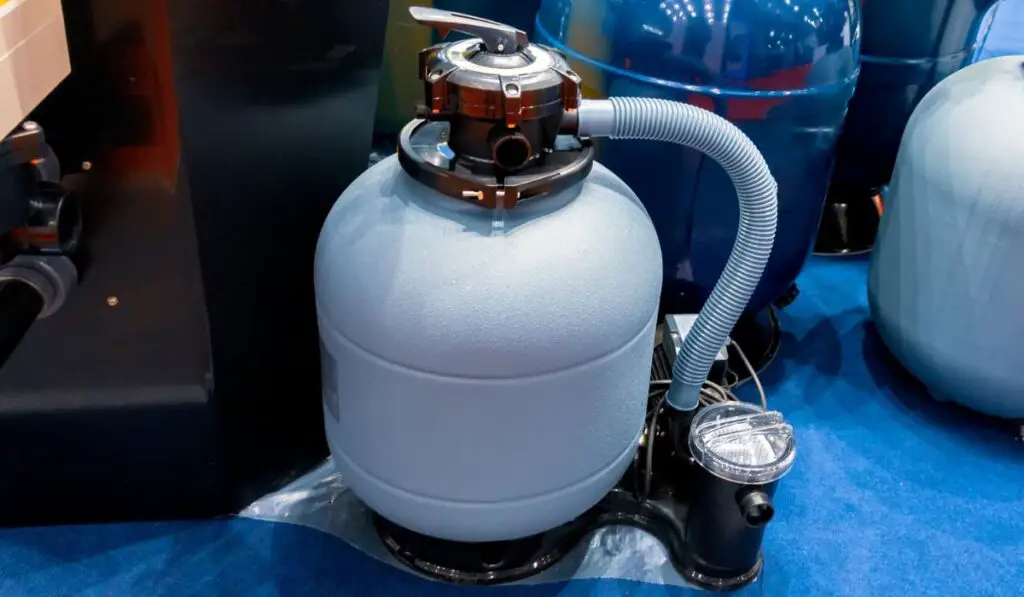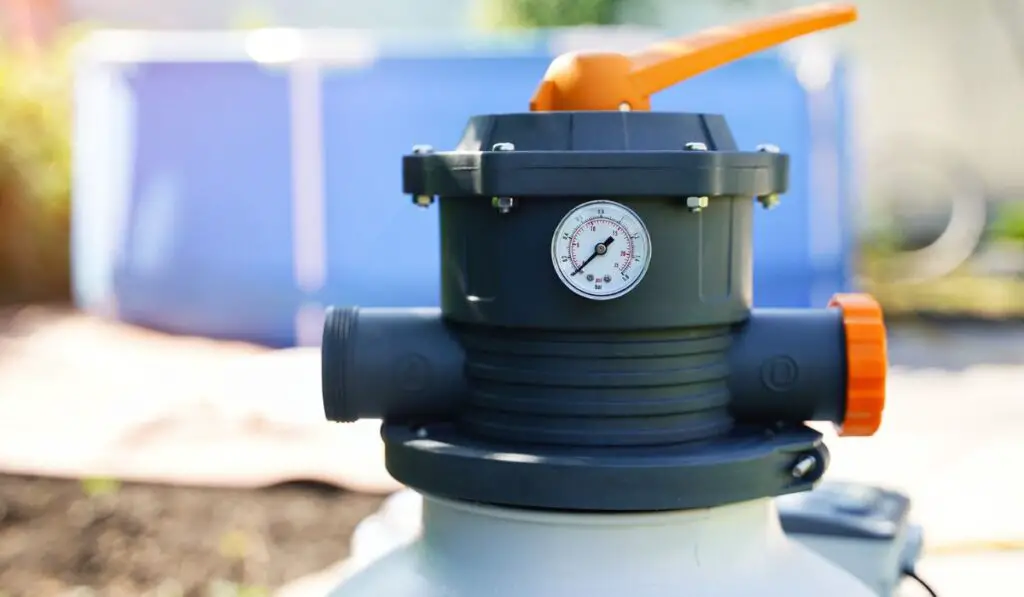You’ll need to backwash regularly to keep your pool clean and the filtration system running smoothly. Therefore, understanding how the backwashing process works and when to do it should be at the top of your priority list.
To backwash your sand filter, switch off your pump and set the filter valve handle to Backwash. Turn the pump on and backwash. Turn off the pump again and set the valve handle to Rinse. Turn the pump off after rinsing, return the valve handle to Filter and turn the pump back on.
With that brief overview of how to backwash your sand filter, let’s get into the details, so you know when it’s time to backwash your filter, why it’s crucial to backwash it and how often you need to do it.
How Does a Sand Filter Operate?

Sand filters like this one (on Amazon) utilize sand as their filter media. You read it right, sand! Your pool water passes through this sand which filters out all the gross stuff, including dirt, debris, and even some bacteria-causing waste.
Interestingly, the sand filter doesn’t just use any sand, so you can’t cheat the system by filling it with bucket loads of sand from the beach or your local park.
Most sand filters require pool sand, usually #20 silica sand, which has huge grains with jagged edges, unlike your regular sand. You can find it at any pool store or some hardware stores.
As your pump pushes the pool water through the filter, the high pressure moves it from the top to the bottom of the tank, where it passes through the sand. Since the sand has rough and point edges, it traps the contaminants, and the clean water passes through and is pumped back into your pool.
How Do You Backwash a Sand Filter?
You don’t need to be a pool expert to be able to backwash a sand filter. It’s a simple process you can do in a few minutes. Here’s how:
- Turn off your pump and set the filter multiport valve handle to Backwash, and ensure it locks into place.
- Attach your backwash hose to the filter’s waste (drain) port and direct the hose to drain wherever you want.
- Turn your pump back on and backwash for 2-3 minutes or until the water in the sight glass becomes visibly clear.
- Turn the pump off and set the multiport valve handle to Rinse and ensure it locks into place.
- Turn the pump back on and rinse for around 1-2 minutes or until the water in the sight glass is visibly clear. Rinsing after you’re done backwashing is essential as it prevents extra debris from getting pushed back into your pool.
- Turn the pump off and return the multiport valve handle to Filter.
- Remove the backwash hose and turn the pump back on. That’s it. You’re done!
Backwashing Tips and Tricks
When backwashing, keep the following tips and tricks in mind:
- A significant downside of backwashing your sand filter is that it wastes a lot of water expelled from the system and sent into the waste. While you can’t prevent this, the best way to avoid over-backwashing and flushing out more water is to carefully watch the color of the sight glass.
- Don’t backwash for longer or more frequently than necessary. The sand filter works most efficiently in the middle of the filtration cycle, partly due to the cyclical accumulation of collected dirt and debris in the filter and partly because of the positioning of sand in the filter. The effect of too much or too frequent backwashing is that it reduces your sand filter’s efficiency.
- Washing out some of your sand along with the debris and dirt when backwashing is inevitable. Therefore, you’ll have to top up the amount of sand in the filter after every backwash session. To reduce the amount of sand blowback into your swimming pool, run your filter on Rinse for a minute after the top-up.
- Ensure you always turn off the pump before resetting the multiport valve handle, or you’ll damage or destroy the system, which will be a costly mistake.
Signs it’s Time to Backwash Your Sand Filter

Knowing when to backwash your sand filter is crucial in keeping your pool water clean and your filtration system in optimum working condition. Three common signs show it’s time to backwash your sand filter. They include:
Increased PSI
PSI (pounds per square inch) measures your filter’s operating pressure. Pool filters have a pressure gauge that indicates your PSI, which varies depending on your pool.
Find out your filter’s baseline pressure and keep an eye on it every time you check your chemistry levels. As a rule of thumb, it’s time to backwash your filter whenever your PSI reads 8-10 lbs above the normal baseline.
Decrease in Water Clarity
If you notice your pool water is a little cloudy or see debris floating around, it most likely implies that your filter isn’t working as well as it should and needs a backwash. You may also notice high total dissolved solids (TDS) levels when you test your chemistry levels.
Drop in Flow Rate
Another indication that you need to backwash your filter is if there’s a drop in its regular flow rate or GPM (gallons per minute). Every filter and pump has its standard GPM, usually mentioned in your manufacturer’s guide. You can also find it out by searching for your particular model on Google.
Measuring the flow rate is complicated because most pools don’t have pool flow meters. So it’s a great idea to install one into your plumbing line if you want to know the flow rate.
However, if you can’t install the pool flow meter, then you’ll have to rely on checking if your water is cloudy or whether the PSI has increased to know when it’s time to backwash.
Why is it Important to Backwash Your Sand Filter?
As pool water flows through your sand filter, the sand traps and collects dirt and debris from it but as the water continues passing through, the sand becomes clogged up, reducing your filter’s effectiveness. Ultimately, all the contaminants back up in your pool and cloud the water.
Backwashing prevents this as it sends water back through the filter and drains out the waste port, forcing all the trapped dirt and debris to dislodge, restoring your filter’s standard functionality.
To prevent residual blowback into your pool, it’s best to rinse the filter immediately after you finish backwashing. Just as backwashing lifts and flushes the sand, rinsing resets the sand to its original position for optimum filtration.
How Often Do You Need to Backwash Your Sand Filter?
You should backwash and rinse your filter about once a fortnight. The best time is right after vacuuming your pool. But if you’ve used your pool more frequently than you usually do, you may have to backwash it once a week.
You must also backwash if your sand filter system’s gauge reads beyond the normal operating pressure- between 50 and 75 Kpa. So, if the reading on your pressure gauge is north of 80 Kpa, get ready to backwash.
Additionally, if leaves keep falling into your pool, you may have to backwash your filter more often. Investing in a good pool cover is the best way to prevent the leaves from dirtying your pool. It will also reduce the need to backwash your pool filter now and then.
